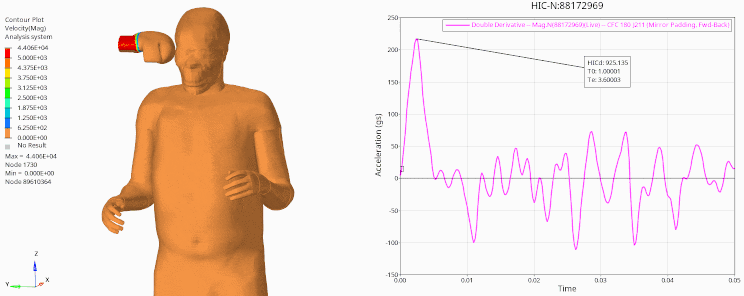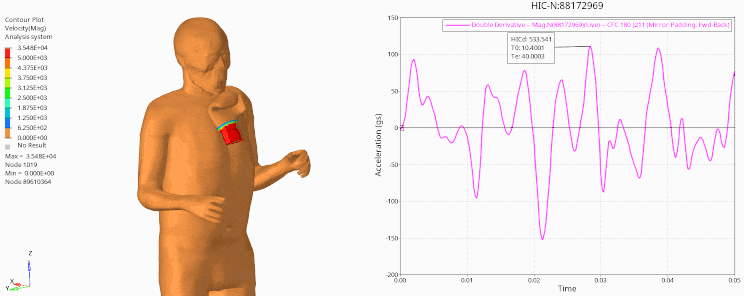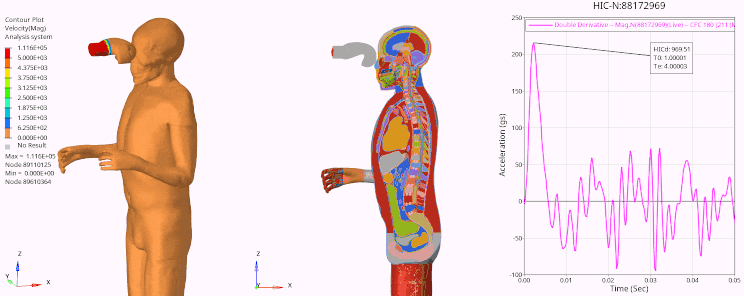Simulating the Impact of a Mike Tyson Punch
In this post, we look at answering the question "What would happen if I got punched by Mike Tyson?". Using Altair Radioss to simulate a Hook, Jab and Uppercut to see the result.
Mike Tyson is back in the ring this Friday night, November 15, against Jake Paul. Known for his devastating knockout power, it got me wondering what the impact of a Mike Tyson punch would be to the head. In this post, we’ll explore how Altair Radioss, a high-fidelity finite element analysis (FEA) tool, can simulate the impact of a Tyson punch on a human head, shedding light on the science of force, impact, and injury.
The Mechanics of a Punch: Why Tyson’s Punch is So Powerful
Mike Tyson’s punches are legendary for their speed, accuracy, and above all, their power. A punch is essentially the transfer of kinetic energy from the boxer’s body into their opponent, channeled through the fist. Tyson, known for his technique, delivers explosive force by leveraging his core muscles, shoulders, and arms. To illustrate how powerful these punches are: An average persons punch would garner somewhere between 150 and 250 lbf (pounds of force), according to Omni Calculator. Compare that to an estimated force of a Tyson punch being near 1,200 lbf.
To understand the full impact of Tyson’s punch, let’s break down some key physics principles:
- Acceleration: Tyson’s punch reaches high speeds in a short time, maximizing impact force.
- Mass and Force: His muscle mass and precise control enable him to apply more force to the punch.
- Impact Area: The force is concentrated over a small area, maximizing pressure at the point of contact.
Why Altair Radioss for Simulating Tyson’s Punch?
Altair Radioss, included in the Altair HyperWorks platform, is well-suited for simulating high-speed impacts and crashes, making it an ideal choice for analyzing the physical effects of a Tyson punch. Radioss allows engineers to model complex interactions of force with real-world accuracy, handling the rapid energy transfer involved in Tyson’s punch as it impacts the head.
Radioss can create a detailed model of the human head that includes various tissues, bones, and muscle structures, accurately replicating how they behave under impact. By inputting Tyson’s punch speed and mass, we can simulate a punch’s effect on the head and observe the distribution of forces and resulting strain across the skull and facial bones.
Setting Up the Simulation: Model and Parameters
- Human Model: We used a finite element model of a human body, THUMS - Total Human Model for Safety, which included material properties for simulating bone and tissue.
- Punch Characteristics: Tyson’s punch involves unique force and trajectory parameters. For the simulation, we wanted to look at the different types of punches like a Hook (punch to the side of the head), a Jab/Cross (punch straight on to the face) and an Uppercut (a punch from underneath to the chin).
- Contact and Boundary Conditions: To realistically simulate the interaction between Tyson’s fist and the head, we set up a contact model between the fist and the head surface, including boundary conditions for the neck. These conditions allow the head to respond as it naturally would under such impact.
To clarify before we look at the results, we are looking at the worst-case scenario. Essentially, if a person’s head was left undefended, with no head gear and Tyson was in his prime.
Visualizing and Interpreting the Results
To see the results of the different punch types, we can use Altair HyperView. The main result we are looking at is Head Injury Criterion (HIC), which is a measurement that shows the likelihood of a head injury from impact. HyperWorks has a built-in HIC/Pedestrian Impact model so no extra calculations are needed.
So, on the lower end of the scale, a HIC between 135-519 would be considered a minor injury level and could result in headache or dizziness; while a score of 900+ would be considered “Serious” and could result loss of consciousness or bone fractures.
Hook

You can see from this animation that the results of a Hook could be devastating, generating a HIC Score of more than 925, which puts this clearly into a “Serious” head injury.
Uppercut

The result from an uppercut, while not as high of a HIC score, still scores more than 533, which puts it as a "Moderate" level head injury.
Jab/Cross

The Jab/Cross could potentially be the most powerful punch in the group scoring 963, which identifies it as a “Serious” level head injury as well.
With the excitement around Tyson’s return to the ring, we are reminded of the incredible forces at play in high-stakes sports like boxing. Altair Radioss allows us to quantify and visualize these potential forces.
By using Radioss to study this iconic punch, engineers and scientists can better understand impact-related injuries, contributing valuable insights across fields like sports medicine, helmet design, and automotive safety. As Tyson steps into the ring once again, we can appreciate not only the raw athleticism on display but also the powerful science that enables us to understand the force of his punches with precision and detail. It you want to learn more, contact us directly.
